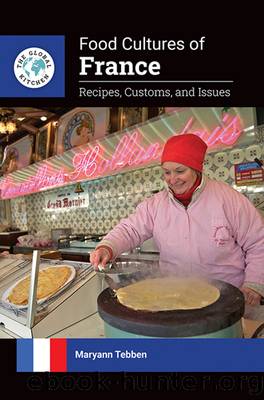Food Cultures of France: Recipes, Customs, and Issues by Maryann Tebben;

Author:Maryann Tebben; [Неизв.]
Language: eng
Format: epub
Publisher: ABC-CLIO
Published: 2021-06-20T21:00:00+00:00
White wine from the Champagne region had a following at the sixteenth-century French court because these light wines were more expensive (and therefore a status symbol) and were thought to be healthier than heavy red wines. The wines from Ay, a town in the Champagne region, had the best reputation of all, highly praised by the king and his entourage (Dion 1959, 632). A monk in the neighboring Abbey of Hautvilliers whose name was Dom Perignon focused his wine-making efforts on perfecting these fine white wines, following the tradition of monastic wine production, and wine from Champagne further polished its reputation. But these early wines did not yet have their signature sparkle. In the late seventeenth century, a new technique called fining (adding a substance to remove impurities) produced clear, bubbly wines. In the eighteenth century, winemakers discovered that racking (pouring aged wine into a new container) allowed them to remove the sediment left from spent yeast and sugar, making these fine wines even better and more profitable because they earned a higher price (Brennan 1997, 248). Only in the eighteenth century, when consumers began to seek out sparkling wines as a fashionable drink, did modern champagne as we know it take France and the world by storm.
The monk at the Abbey of Hautvilliers, Dom Perignon, would later be called the father of French champagne but only after a publicity campaign in the nineteenth century invented the story that would retroactively create the myth. Dom Grossard, a former Benedictine monk, began a campaign in 1821 to celebrate the accomplishments of the Hautvilliers abbey, including the invention of sparkling wine attributed to Dom Perignon but with no evidence to support his claim. The practice of adding sugar to create a second fermentation and produce bubbles in wine or cider had been used since the late Middle Ages. Nevertheless, at the 1889 Universal Exposition in Paris, the union of Champagne wine producers distributed an illustrated pamphlet telling the story of Dom Perignon and naming him the âfatherâ of sparkling wine (Guy 2003, 28). In the 1880s the wine producers worked to earn sparkling wine from Champagne a special status. By 1900 the name champagne designated a natural product of the Champagne region that was made mousseux (bubbly) by a second processing phase, distinguishing it from sparkling wine from other regions that used the second fermentation technique. Then as now, the term champagne legally designates the wine from this region created with this technique; other sparkling wines are forbidden from using the name âchampagneâ and must instead use terms like méthode champenoise (Champagne method) or vin mousseux (sparkling wine).
Geography generally determined good wine in the eighteenth century. The Bordeaux region produced a quarter of all French wine in this period, and wines from Burgundy had long been recognized for their excellent quality. As a âcommon goodâ like bread and meat, wine earned protectionist measures from the government, with a greater effect on Paris, where wine brokers held a monopoly on river traffic, effectively closing the Seine to regional producers hoping to sell their wine directly in the city.
Download
This site does not store any files on its server. We only index and link to content provided by other sites. Please contact the content providers to delete copyright contents if any and email us, we'll remove relevant links or contents immediately.
| Eastern European | English, Scottish & Welsh |
| French | German |
| Greek | Hungarian |
| Irish | Italian |
| Mediterranean | Polish |
| Portuguese | Russian |
| Scandinavian | Spanish |
| Turkish |
Biscuits: A Savor the South Cookbook by Belinda Ellis(4216)
A Jewish Baker's Pastry Secrets: Recipes from a New York Baking Legend for Strudel, Stollen, Danishes, Puff Pastry, and More by George Greenstein(3452)
Al Roker's Hassle-Free Holiday Cookbook by Al Roker(3428)
Ottolenghi Simple by Yotam Ottolenghi(3428)
The French Women Don't Get Fat Cookbook by Mireille Guiliano(3415)
Better Homes and Gardens New Cookbook by Better Homes & Gardens(3372)
Trullo by Tim Siadatan(3304)
Bake with Anna Olson by Anna Olson(3279)
Hot Thai Kitchen by Pailin Chongchitnant(3215)
Panini by Carlo Middione(3166)
Nigella Bites (Nigella Collection) by Nigella Lawson(3096)
Momofuku by David Chang(3053)
Modern French Pastry: Innovative Techniques, Tools and Design by Cheryl Wakerhauser(3029)
Salt, Fat, Acid, Heat: Mastering the Elements of Good Cooking by Nosrat Samin(3000)
Best of Jane Grigson by Jane Grigson(2871)
Tapas Revolution by Omar Allibhoy(2855)
Classic by Mary Berry(2837)
Solo Food by Janneke Vreugdenhil(2825)
The Club by A.L. Brooks(2748)
